Neil Peart's News, Weather and Sports
The Ballad Of Larry And Suzy
NeilPeart.net, September 2009
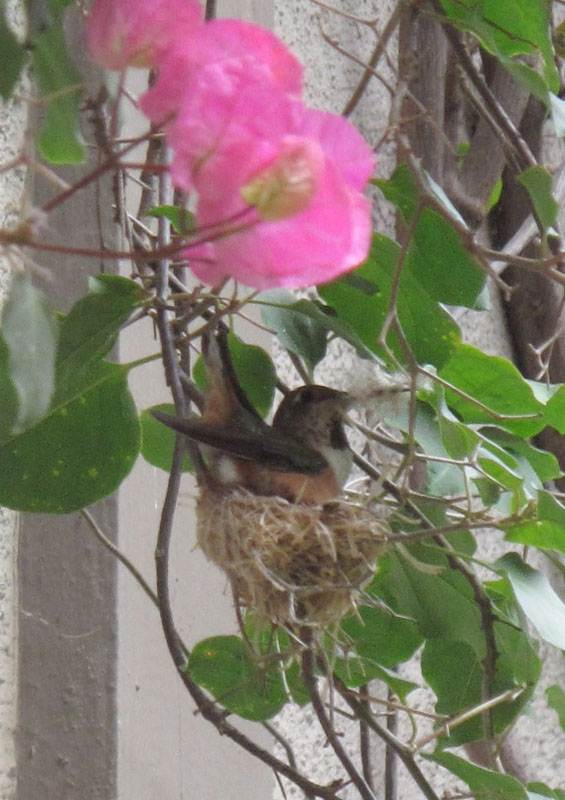
In a previous story, "Under the Marine Layer," I wrote about watching a hummingbird build her nest in the bougainvillea vines on the wall of our house. She gathered dried grasses and flower petals and wove them into a tiny bowl bound with spider silk. The lining of softest plant down was shaped with her body, which was about the size of my thumb. The nest was an exquisite egg cup, crafted by a meticulous Fabergé. She belonged to a species called Anna's hummingbird, after a nineteenth-century Italian duchess, so I named her Anna. Once I had spotted that nest, I kept a vigilant, protective eye on it, day after day.
I felt an irresistible connection with Anna, and a strong guardian instinct for her nest, because at the same time as Anna was preparing to lay her eggs in late May, my wife Carrie was seven months pregnant. My anxiety about that enterprise was projected and distilled into Anna's little nest, filling it with my fears and dark forebodings. Some of those fears were garishly clear in harsh, unyielding memory, while others bred in the shadowy unconscious, in tormented dreams. Tormenta is Spanish for "storm," and my interior weather was ominous and unsettled, temperature high and barometer low. The gathering storm generated a kind of pathetic fallacy in reverse, manifesting itself in my anxious concern for the wellbeing of Anna and her nest.
That nervous watchfulness soon blossomed into an aching, near-obsessive fretting, and several times a day I would find myself detouring into the backyard, sometimes just for a peek, but other times staying for a while, taking along some reading and writing, or my Macallan on ice at the end of the day. I would sit at the outdoor table across the lawn from the nest - close enough to keep watch, but far enough not to be intrusive. From time to time I raised my binoculars and focused on Anna's perfect stillness as she sat there, hour after hour, and I wondered what she was thinking. Essentially, and profoundly, she was just doing what she had to do.
Anna settled into her nest and rarely left it, except briefly in late afternoon, when the sun was on the nest - to keep it warm, I guessed. She buzzed around the garden, darting from flower to flower for a quick feed, then perched on a branch above me, in sight of the nest, and groomed herself for a few minutes. While most birds preen themselves with their bills, Anna had to use her feet - she perched on one foot and used the other to comb her feathers, then switched over, because the long needle bill that was so perfectly adapted to sipping floral cocktails was not so adaptable as a grooming accessory. I watched her little string of a tongue flick out a few times, and from the other end, she ejected an impressive jet of liquid.
Then all at once, in a blur, she would be gone again, arrowing back to the nest, almost too fast to see. It was wonderful to study Anna's flight, to watch her hovering in place while she fed, even flying backwards among the flowered vines. If any other hummingbirds approached within about thirty feet of Anna's patch of bougainvillea, she would zip out like a fierce bullet and drive them off. No wonder hummingbirds' hearts can pump at over 1,000 beats per minute, and that they have to eat the equivalent of their own body weight every day to sustain that outpouring of energy.
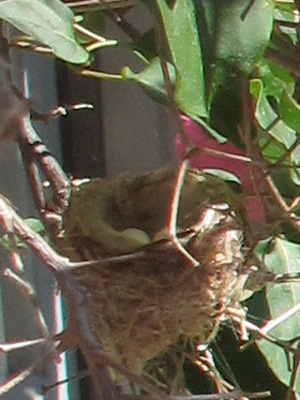
One afternoon in early June, Anna was away from the nest, perched in a tree above my table and taking a little "me time" in the lowering sun. I fetched my ladder from the garage, leaned it against the wall, and climbed as high as I dared. With one hand holding onto the wall, my other hand reached my camera as high as I could above the nest, then aimed it downward between the leaves (my remote-framing ability practiced by the Action Self-Portrait photos I took on my motorcycle, as seen in many previous stories). When I viewed the resulting image, I was delighted to see two tiny white eggs, each smaller than the tip of my baby finger.
I also saw that I wanted to improve my nest-photographing techniques, and worked on that in the coming days. I found myself growing ever more attentive, visiting the backyard many times throughout the day, just to check on her. One morning I heard a commotion outside, and the squawking of crows - notorious nest robbers. With a start of fear, I raced out to chase them away, hoping I wasn't too late, but the bird community had the situation well in hand. Four different species, a robin, a mockingbird, a sparrow, and a hummingbird - Anna - were working together, mobbing a pair of crows, driving them away from all of their nests. I had never witnessed that kind of inter-species cooperation before, and it made me smile - and not only from relief. It is common to see a pair of sparrows or starlings harassing crows that way, and crows routinely nag at patrolling hawks, but that alliance of so many different birds was like a scene from a Disney movie.
I did some research into the nesting habits of hummingbirds, and learned that Anna's eggs should hatch in a little over two weeks. During that time, there were many dangers and disturbances I had to guard them against. One morning a team of workers came to spray around our house - a necessary retaliation against a recent invasion of ants (a transplanted Canadian like me appreciates the lack of mosquitoes and black flies in Southern California, but I can still be appalled to walk into the kitchen in the morning and see thousands of ants swarming over any dishes left in the sink, and over the dog's food bowl). The pest-control company claimed they sprayed with "green" insecticides, but I warned the workers not to spray near Anna's nest, and to try to stay clear of the area as much as they could. I was afraid too much human activity would drive Anna from her nest permanently, for if birds are kept away from their eggs too long, they will abandon them. I couldn't stand for that to happen.
Later in the day, when the workers had gone, I sat outside and watched to make sure that Anna was back on her nest - surprised at the intensity of my relief when I saw her return and settle herself above the eggs. A few days later, another team of workers came to work on our air conditioning system, replacing the air pumps behind the garage, right near the nest. Once again, I warned them sternly against disturbing it, and when they were gone, I was back at my table, watching to make sure Anna had returned.
Late in June, I started to see Anna making brief forays away from the nest all through the day, and I wondered if the eggs had hatched. When the afternoon sun was on the nest, I saw Anna perched above me, attending to her own grooming for a few minutes. I got out the ladder again and climbed up to aim my camera down into the nest.
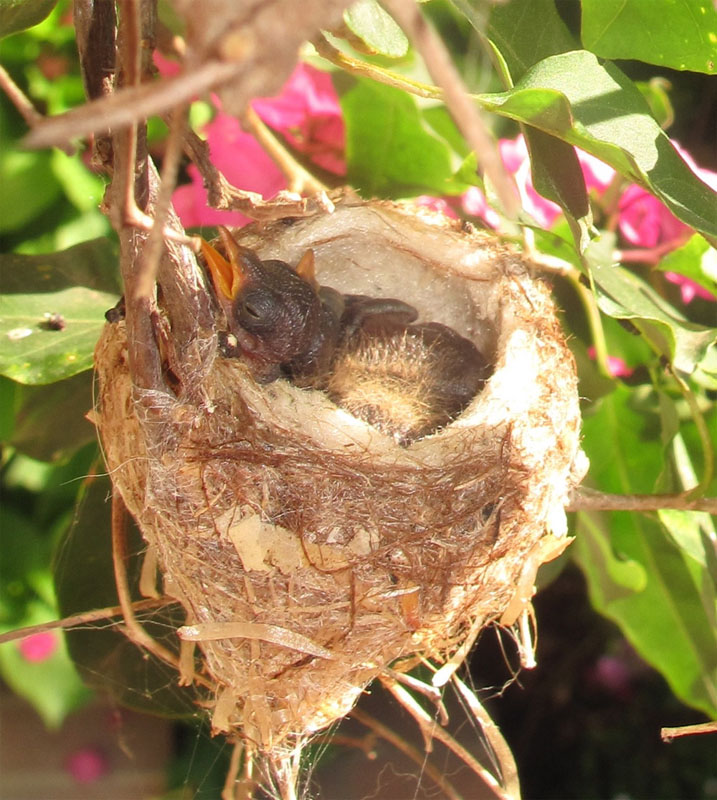
When I looked at the screen to see what I had captured, I was thrilled to see two tiny little babies, still almost featherless, their bright orange bills half open (many young birds of different species have that fluorescent kind of beakage, and it is thought to help attract their mothers to feed them). You can see there was nothing recognizably "hummingbird" about them yet.
Carrie was almost eight months pregnant now, so it was a matter of only a few weeks, even, possibly, days. (A phrase from the Summer of Love I somehow remember, "Love comes like birth, knowing its own time.") As that time grew steadily more imminent, yet remained uncertain, unknowable, it assumed greater size in my imagination. My worries swelled and multiplied, and I began to feel a constant state of tension, even dread, added to what I came to realize was an attempt at inner resolve. As if trying to warn myself; prepare myself; convince myself; I was thinking, "Whatever happens, you're going to have to be ready to handle it."
I began to think of those two baby birds and their mother as My Little Metaphors.
Soon, though, they had real names. I sent the above photograph to my friend and fellow bird-lover, Craiggie, and when he showed it to his eleven-year-old daughter, Selena, she said, "Ooh! They're so cute! Tell Neil to call them ... Larry and ..."
She paused. "Hmm. Rose? Sally?"
She fidgeted and thought, swaying from side to side, then said, "Oh, I know - Suzy! That's a good name."
So Larry and Suzy they were. There was no way to tell them apart, of course, or even their genders - like most young birds, baby Anna's hummingbirds are indistinguishable gender-wise. However, I was under no scientific responsibility to avoid anthropomorphism, and as they grew and developed I invented characters that fit the behavior I witnessed. Typically, a hummingbird's second egg is laid a day later than the first, and thus hatches like that, so the second chick remains smaller and less developed. With some bird species, the firstborn chick, larger and stronger, will heave the smaller one right out of the nest - either accidentally or on purpose, jockeying for more food. (The common loon of our northern lakes is one species I know where the parents will even begin to ignore the smaller chick at feeding time, letting it starve - perhaps at a time when fish are scarce, and thus maximizing the odds for one survivor.)
Nature's only two commandments for living things: Survive and Reproduce.
So I started to worry about Larry or Suzy falling out of the nest and tumbling to the ground. Even a metaphorical parent has so much to worry about - and, as I knew too well, the worries are, literally, endless.
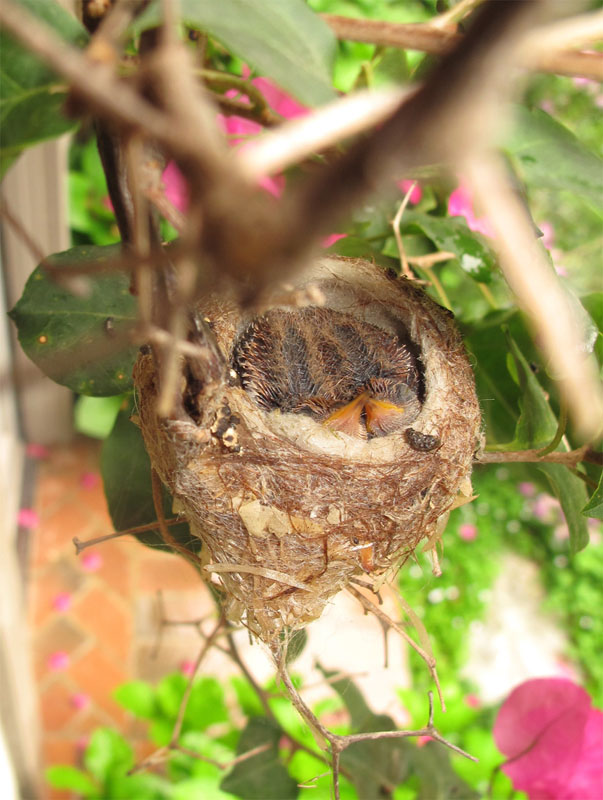
One day I noticed that an overflow pipe up by the eaves was dripping a little water down above the nest. Though it was pretty well sheltered by the bougainvillea vines and leaves, I worried that even a drop or two of water would be enough to soak Larry and Suzy, or the tiny nest around them. I had dark imaginings of hypothermia, picturing them shivering and helpless in their cold, wet bedding. While I fretted thus, I saw Anna fly to the nest and perch on its edge, but she was obscured by leaves, and I couldn't see if she was feeding them. It looked to me like she wasn't moving at all, and I pictured her just sitting there, looking down mournfully at her dead babies. As soon as she left again, I reached up with my camera and took a photo - to reassure myself that Larry and Suzy were still alive.
There they were, dry and cozy, looking like a pair of fuzzy brown caterpillars, or tiny down sleeping bags - each of them still smaller than the end of my little finger.
Every day - many times a day - I kept watch from my outdoor table, seeing Anna fly off to feed and bring back a gullet full of nectar, and (I learned) the occasional small insect, caught on the wing or scavenged from a spider's web. I certainly had never thought of hummingbirds as carnivores, but years ago I was surprised to learn that many other birds I used to think of as vegetarians, like finches and sparrows, actually flew north to breed in the Arctic regions because that intensely buggy zone provided a high-protein diet of insects to better nourish their young. When birds have babies to feed, they want more than seeds and berries.
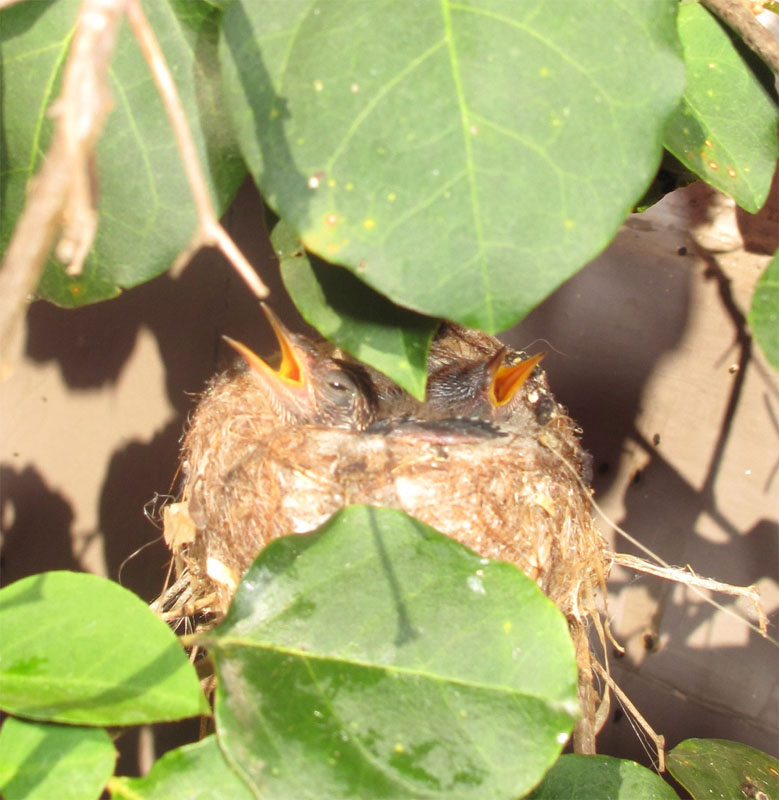
I tried to take at least one photograph of Larry and Suzy every day, and I was astonished to see how fast they grew - just on regurgitated flower nectar and occasional little bugs. Within a few days I was catching glimpses of tiny orange bills poking up out of the nest, gaping wide as they waited for food. Larry and Suzy were still incredibly small, but their bills lengthened noticeably every day, and their feathers grew into a comically spiky plumage. (Larry and Suzy's inevitable punk stage. I'll write a verse like that for their Ballad.)
I loved to watch Anna feed them, too - flickering in behind the leaves to perch on the edge of the nest, while Larry and Suzy's orange bills pointed up and gaped even wider. She would stick her long bill way down their throats, then shake with a kind of rhythmic convulsion, head pumping like a sewing-machine needle as her tongue transferred the nourishment. Each chick got two quick feedings, then Anna was gone again, to gather their next meal.
Witnessing these scenes, I swelled with a sense of feeling privileged - somehow honored to be able to share this intimate view of a wild family, miraculous, adorable, and somehow more than just "natural" - maybe "supernatural." I had never seen anything like that, in fifty years as a casual birdwatcher ("casual," because I have never kept a life-list of all the birds I've seen, and unlike serious birders, I've never traveled anywhere just to see birds - but wherever I do travel, I always love to look at the birds and learn their names).
As Larry and Suzy grew larger, they seemed to be crowding each other right out of the nest. Like two overgrown adolescents on a schoolbus, they jostled for space, occasionally flexing their little wings and giving them an experimental flutter, always in each other's way. One time I laughed as Larry was waving his wings around, and with every stroke one of them banged into Suzy's head. She just sat there, looking indignant, but patient. I never saw them act aggressively toward each other, but I did notice they often faced in opposite directions, either for more space, or to avoid the very sight of their annoying sibling (anthropomorphizing again). But I still worried that one of them was going to shove the other out, and I pictured it tumbling helplessly to the ground. I wondered what I would do if that happened. Would I "play God" and rescue the fallen one, return it to the nest?
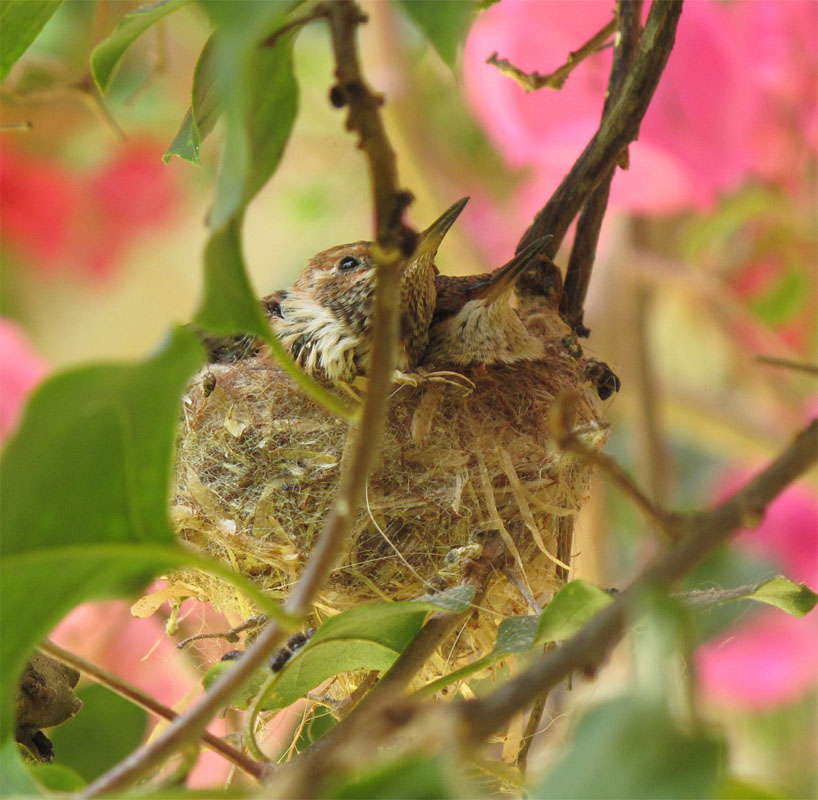
The answer seemed clear, "Hell yeah!"
Even as Larry and Suzy continued growing, so too did Carrie's belly, and the baby inside. Ultrasound examinations had revealed that she was a girl, and that - alas - she seemed to have Daddy's nose. I hoped she would grow into it ...
Carrie and I attended a couple of lengthy birthing classes, which included graphic, gory DVDs of the labor and birth process, and there were painful-sounding descriptions of the complicated (and risky) series of steps, each one demonstrated with a lifesize doll and model pelvis bones. So many things had to happen just right that you wondered how anyone managed to be born successfully.
Most significant to me, so many things could go wrong.
We toured the birthing unit at the local hospital, shared another in-depth class on newborn care, and I signed up for a one-and-a-half hour course on infant car-seat installation and adjustment (seriously - and it was necessary). The last time I became a father was thirty years ago, when my daughter Selena was born in 1978, and it can hardly be overstated how much things have changed in three decades - not least my own blithe self-confidence that, in those days, allowed to me trust that everything was going to be all right. Since Selena's death in 1997, at age 19, I no longer had that faith.
What I did have was a bottomless well of fears for all those I cared about, and in this case, not just for all that could go wrong with the developing baby, and with a mother in childbirth, but recognizing that even given the best-case scenario - a healthy baby - my fears would only be beginning.
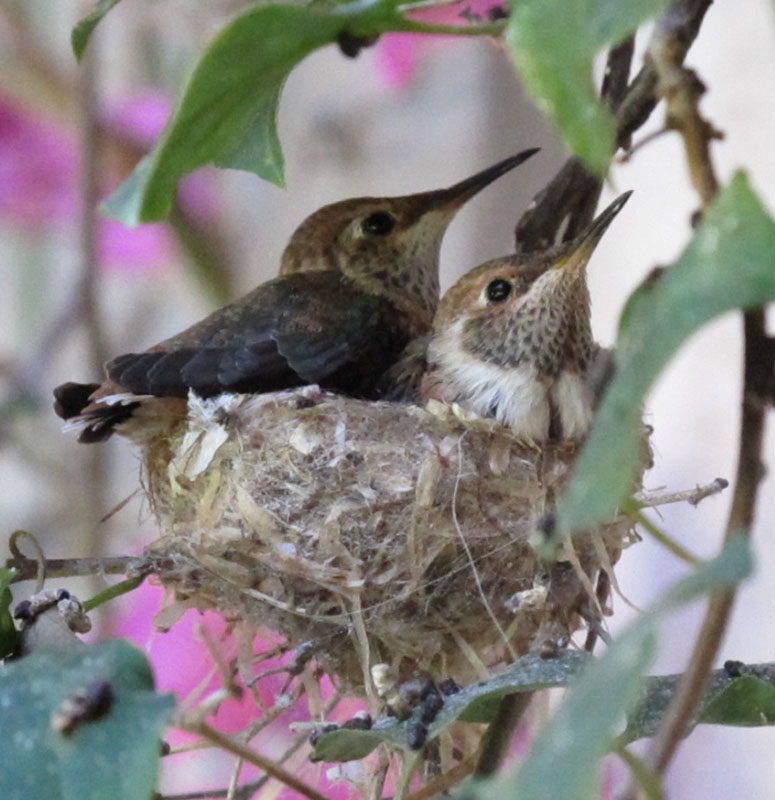
August 10 would be the twelfth anniversary of Selena's death, and Carrie's due date was August 12, so I was also sending out supplications to any available deity that the new baby not be born two days early - it would be awful to have her birthday fall on what would always be the worst day in my calendar.
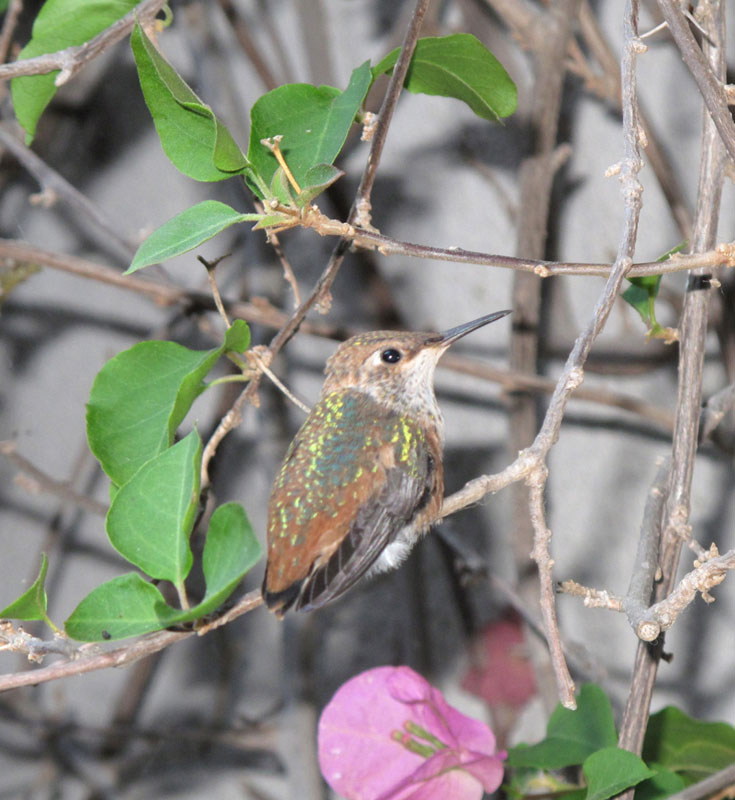
By mid-July, Larry and Suzy had been growing for three weeks, and they looked pretty grown-up. The nest seemed impossibly crowded now, and I knew they would be leaving soon, but I was still surprised when I came out one morning and saw only one baby in the nest. Larry was gone - though he hadn't gone far. I spotted him perched on a nearby vine, as still as a flower, and it was a wonderful opportunity for me to get up close and marvel at his delicate plumage, its gemlike spots of metallic green, the combination of chestnut and buffy white, and the dark tracery edging his wings. I stared long into the shining bead of his eye, but as with all wild creatures, it revealed nothing of its depths.
From the table across the yard, I continued watching through my binoculars, and several times that day I saw Anna perch beside Larry and feed him, then continue on to the nest to feed Suzy. Larry didn't move all that day and night, for I found him in the same spot the next morning, but later that day, he was gone. It bothered me to think that I would never be able to be sure of seeing Larry again, among all the hummingbirds that visit our flowers (the avian franchise of Bubba's Bar 'n' Grill).
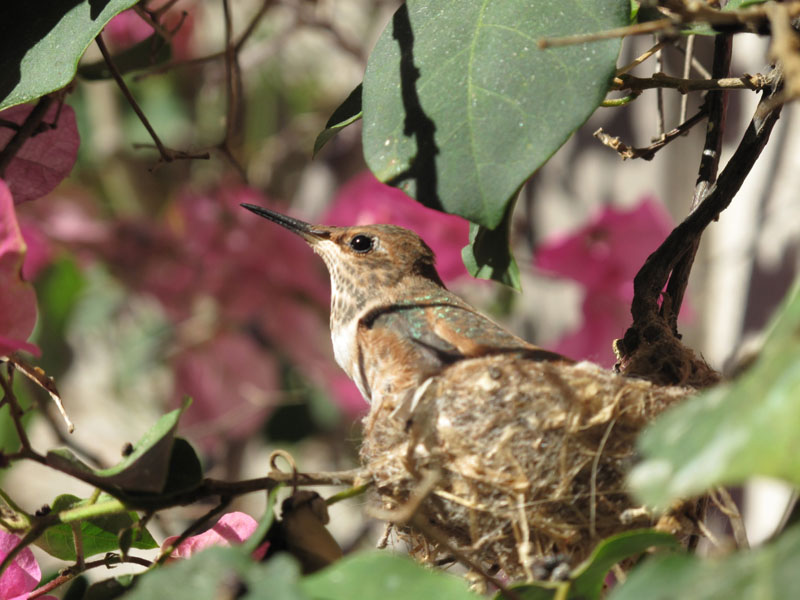
Suzy, meanwhile, was obviously nervous about taking that first flight. On one visit I would see her perched on the outside of the nest, as if ready to try her wings, but the next time I looked I would see her back inside its safe haven, having failed to summon enough courage to go.
That occasional dance to the outside edge of the nest, then back inside, continued for two whole days, until finally, on the morning of the third day, the nest was empty. My first and dominant emotion was relief - that they had both survived long enough, under my vigilance, to gain their independence - but of course I felt a little regret, too. I joked to Carrie, "Now what am I going to do?"
I had been watching over Anna's nest, her eggs, and then Larry and Suzy, since late May. In those six weeks I only missed five days, while I was away on my motorcycle journey to Yellowstone National Park. From then on, all through the writing of that story, and the other activities of a busy life, I had been slipping outside to check on the nest, or settling at the table to read over my work with my binoculars at hand - infatuated with the growing family, inspired and delighted, somehow even comforted by them, while at the same time feeling tense and fearful for their survival.
Those feelings had ramped up as Carrie's due date approached. For the first time in many years, my fingernails were nibbled raw, and in those final weeks I had been trying to keep myself usefully occupied - working out at the Y, spending several days up at the Drum Channel studio exploring some rhythmic ideas (plus enjoying the wonderful drive up and back on the Pacific Coast Highway in my old DB5), and planning, shopping for, and preparing nutritious meals for Carrie.
Our five-year-old golden retriever, Winston, needed extra attention, having been a "mama's boy" all his life, and - with his sensitive heart and genius brain - sensing change in the household atmosphere. With Carrie suffering from insomnia and growing discomfort (literally!), I spent more time caring for Winston, feeding him and taking him outside, occasionally for father-son walks in a nearby canyon, and trying to give him at least some of the infinite amounts of love he required (since puppyhood we had called him the "genius love-sponge").
All the while, wherever I roamed, my cell phone was always near at hand - ready for that call, and trying to remain prepared, remain resolved.
"Whatever happens, you're going to have to be ready to handle it."
When I was a boy of six or seven, I remember fervently believing that I could prevent bad things from happening if I worried about them enough. Now I recognize that atavistic urge as a primitive kind of prayer, and I was still superstitious enough then to believe in magical thinking. Hoping to escape being found out in a lie, or punished for something I had accidentally broken, I would worry about it long and hard. If, despite all that prayer, my crime were discovered, I would decide that I had simply not worried enough. All unknowing, I had invented my own little religion, the Church of Worry, and it worked the same as all the others: If something bad happens, it's your fault for not having prayed enough.
This time, I guess I must have prayed enough - so far, at least. On August 12, 2009, Olivia Louise Peart hatched into the world.
In early discussions of a possibly long and painful labor, I had said I might not want to remain in the delivery room. People seemed to think I was squeamish about blood, but it was actually about the pain. I wasn't sure how much of Carrie's suffering I could bear to witness. Blood I can take, in small doses, and my own pain I can stand, to some extent, but not a loved one's agony.
But it worked out all right, and I was able to be in the operating room, masked and shrouded in sterile green, for the entire procedure - holding myself resolved, ready for whatever I might have to handle. Later, I said to Carrie's mother that such a situation seemed to require holding a stance that was truly cool - unselfish, detached, neutral. You quite literally have to set your own feelings aside. As has often been observed about behaving well in a crisis, it's not that you don't have feelings - usually quite the contrary - but at critical moments, when cool and efficient action is required, your own feelings are a temporary liability, an indulgence you cannot afford. That way lies surrender and failure. As I mentioned in a letter to my mother a day or two later, what I needed was that old Hemingway quality, grace under pressure.
"... as I've learned before, you don't know what you can take until you've been tested (and ain't that the truth!)."
Lately I had been thinking of an early Hemingway masterpiece, a story called "Indian Camp," where the boy Nick Adams accompanies his doctor father to attend to a young Indian woman who had been in labor for two days, a breech-birth, and was screaming in agony. In the bunk above the suffering woman, her husband lay immobilized by a logging injury, and while Nick's father performed a Caesarean section with a jackknife and fishing line, and no anesthetic, it was the husband who succumbed to the unbearable pain.
The story also has one of those peerless Hemingway ending lines, "In the early morning on the lake sitting in the stern of the boat with his father rowing, he felt quite sure that he would never die."
A couple of times lately in Bubba's Book Club I have touched on the notion that "being good" often simply means "behaving better than we are." Now it occurs to me that being good can also be about behaving better than we feel.
Very important, that notion.
Years ago, on a grueling concert tour, the guys in our road crew came up with an ironic expression of that existential reality. Their slogan began with an upbeat, confident boast, "We have the technology!", then descended to a whiny, abject lament, "But we don't feel so good."
Sometimes in life you simply can't afford not to "feel so good" - when it's showtime.
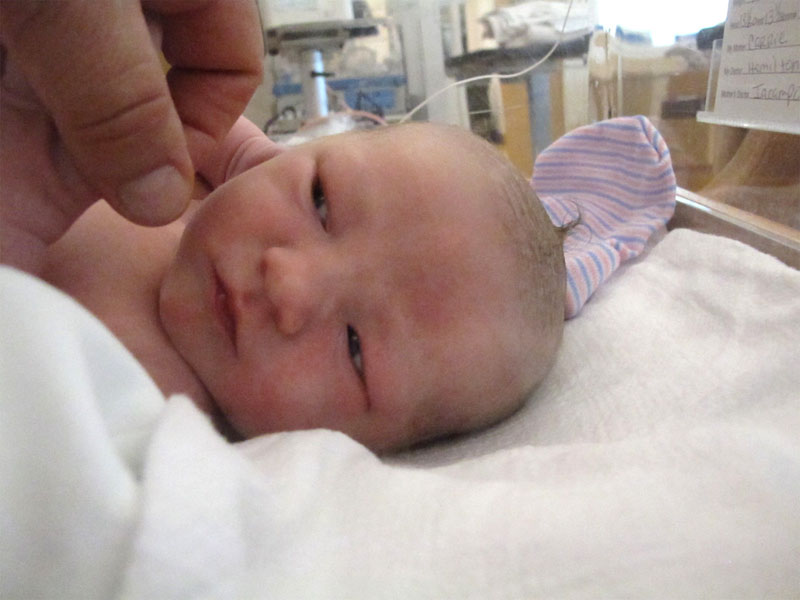
Within a minute after Olivia's birth, I was touching and holding her while the medicos cleared her breathing passages, dried her skin, and swaddled her. Then I carried the tiny bundle over to introduce her to her mother. A few minutes later, I accompanied Olivia on her first journey, down a long hallway to the nursery, where she was weighed (seven pounds twelve ounces) and checked over by the pediatrician.
While she lay there in the clear plastic bassinet, I tried to soothe her (the naked weighing had especially outraged her delicate sensibilities, yet I had smiled to hear her strong cry of protest). I reached my finger into her fist, and felt her tiny fingers close tightly around it.
I whispered, "Hold on, baby, hold on."
I was talking to her, and to myself.